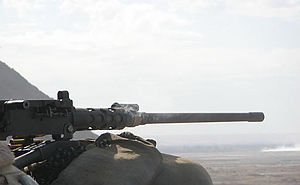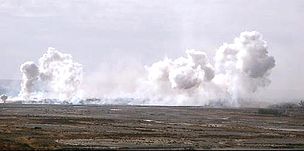- Operation Falcon Summit
-
Operation Falcon Summit Part of the War in Afghanistan (2001–present), Battle of Panjwaii 
A Canadian .50 cal machine gun fires on Taliban fighters while dust rises in the background.Date December 15, 2006 – January 2007 Location Panjwaii district, Kandahar province, Afghanistan Result NATO victory;
Taliban retreated out of the area.Belligerents  Canada,
Canada,
 United Kingdom,
United Kingdom,
 Afghanistan,
Afghanistan,
 Estonia,
Estonia,
 Denmark
Denmark Taliban insurgents
Taliban insurgentsCommanders and leaders  Brig.-Gen. Tim Grant,
Brig.-Gen. Tim Grant,
 Lieut.-Col. Omer Lavoie
Lieut.-Col. Omer Lavoie Local Taliban commanders
Local Taliban commandersStrength  2,000
2,000 900
900Casualties and losses 7 wounded[citation needed] 60-70 killed,
20 captured[citation needed]Timeline
2001 · 2002 · 2003 · 2004 · 2005 · 2006 · 2007 · 2008 · 2009 · 2010 · 2011
Battles and operationsCrescent Wind · Rhino · Mazari Sharif · Kunduz · Herat · Kabul · Tawin Kowt · Shawali Kowt · Sayyd Alma Kalay · Qala-i-Jangi · Kandahar · Tora Bora
Lejay · Eagle Fury · Lashkar Gah · Mountain Thrust · Sangin · Mountain Fury · Now Zad · Achilles · Musa Qala I · Volcano · Kryptonite · Silver · Pickaxe-Handle · Hammer · Nasrat · Musa Qala II · Garmsir · Eagle's Summit · Red Dagger · Shahi Tandar · Diesel · Mar Lewe · Panther's Claw · Strike of the Sword · Dahaneh · Cobra's Anger · Moshtarak · Tor Shezada
Medusa · Avalanche · Kaika · Panjwaii · Falcon Summit · Hoover · Luger · Kamin · Shah Wali Kot · 1st Kandahar · Spin Boldak · Sarposa Prison · Arghandab · Wech Baghtu · 2nd Kandahar · Nadahan wedding bombing · Kandahar
1st Kabul · Hotel Serena · 1st Indian Embassy · Uzbin · Feb 2009 Kabul raid · 2nd Indian Embassy · Bakhtar guest house · NATO headquarters · Jan 2010 Kabul raid · Feb 2010 Kabul raid · May 2010 Kabul bombing · NATO convoy
Kunduz airstrike · Oqab · Chora · Firebase Anaconda · Shewan · Balamorghab · Derapet ·
Airstrikes
Hyderabad · Sayyd Alma Kalay · Gora Prai · Azizabad · Granai · Deh Bala · Sangin · UruzganInsurgent attacks
Bagram Air Base · Baghlan · Camp ChapmanOperation Falcon Summit (Pashto: Baaz Tsuka) was a Canadian-led operation in the Battle of Panjwaii and on a larger scale, the 2001–present War in Afghanistan.
NATO forces launched the operation on December 15, 2006, with the intention of expelling Taliban fighters from the Panjawi and Zhari districts of Kandahar.
Canadian troops had been fiercely battling Taliban fighters in the area for several months. Although the operation was under a British command, the majority of the movements and elements on the ground were Canadians operating from forward operating bases set up in the district during the fighting of Operation Mountain Thrust and Operation Medusa.
Contents
Information campaign
During the early morning hours of December 15, NATO aircraft attacked a Taliban command post in the area, using laser-guided bombs, rockets, and fuel air explosives to blast apart the makeshift fortress the Taliban had constructed out of stone, concrete, and sheet metal. The same day, aircraft began dropping three sets of leaflets over the region, the first warning the population of the impending conflict, the next a plea for locals to turn their backs on the Taliban and support NATO, and the third consisting of an image of a Taliban fighter with a large X through it to warn Taliban fighters to either leave the area, or face NATO.
Landmine accident
During the days prior to the operation, Canadian soldiers held several meetings with tribal elders to discuss reconstruction efforts that would begin, and to persuade locals to help support NATO and to help NATO keep the Taliban out of the area after the Taliban had been removed. While en route to one of these meetings (or shuras in Pashto) a Canadian soldier from the Royal 22e Régiment, the "Van Doos", out of Quebec, stepped on a landmine. The soldier, Private Frederic Couture, suffered severe but non-life threatening injuries and was medivac'd to a coalition hospital where he was stabilized. The landmine had been planted the night before by two Taliban fighters, who were spotted, shot and killed by Canadian soldiers. Engineers then came to clear the area of landmines, but they missed the one that Couture set off. The mine attack was the first casualty of the operation and worked to temper the Canadian resolve.
Preparations for battle
On December 14th in the Helmand province there was increased activity around British bases prior to the announcement of the operation. Soldiers were seen packing large amounts of equipment and ammunition for a long stay outside the wire and troops began moving out towards the area of operations.
Although the Canadian commanders in Afghanistan did not officially announce that the Canadian Forces in the area would take part in the operation until the information campaign had been all but completed, Canadian officers gave very obvious hints that Canadians would be active participants. British commanders also stated prior to this, that if need be Canadian personnel would be called upon for the operation.[citation needed]
Back at the Canadian Forward Operating Bases in the Panjwaii District, soldiers could be seen preparing for battle. Troops were gathering ammunition and web-gear; and last minute checks were being conducted on Canadian armoured vehicles such as the LAV III and Leopard C2 tanks.
Offensive operations
On December 19, the offensive operations of Falcon Summit began. A massive barrage of Canadian artillery and tank fire rained down on Taliban positions in the area of operations which killed around 60 Taliban. The artillery barrage lasted for forty-five minutes and was supported by heavy machine gun fire from Canadian .50 caliber guns. Shortly after the barrage ended, Canadian armoured convoys left the "protection" of being behind the wire and headed out into the area of operations and set up perimeters without a single shot being fired. The Canadians stationed themselves around the village of Howz-e Madad and are said to be on a "soft knock" approach with the villagers to help gain support.
Over the next few days, NATO forces secured several more objective towns with very little resistance from Taliban fighters. Canadian Leopard C2 tanks were requested for support by the head of the Afghan National Army (ANA), but were turned down due to the high number of anti-tank mines littering the ground in the area where the tanks would have been used. Commanders believe that the lack of resistance they have encountered is due to the bombardment of leaflets dropped during the information campaign.
Near the village of Howz-e Madad were a 10-square-kilometre area full of mud-walled fortresses and 900 surrounded Taliban fighters. Canadian infantry and armour surrounded the area, which was ideal for the Taliban's style of attacks. The complex build of the area the fighters were held up in made it nearly impossible to escape from, and to the east of the complex was a road built by the Canadians after Operation Medusa, which ran along the Arghandab River, which made it impossible for any Taliban to escape using the road. Ten kilometres to the south of Howz-e Madad was a line of American soldiers, and to the west were more British soldiers making this a truly combined effort by the three nations to protect the Afghan people living nearby and bring down the Taliban.
After 48 hours passed, the Taliban fired. Two rockets flew past C Company just south of Howz-e Madad. This was responded to by a burst of machine-gun fire from the Afghan National Army, but nobody on either side of the skirmish took any casualties.[citation needed]
After the new year began, on January 5 a 45-minute firefight between about 20 members of the Royal 22e Régiment and a force of Taliban fighters about half that size. Small arms including automatic rifle and machine gun fire, rocket propelled grenades and mortars were used against the Canadians. The Van Doos were conducting operations in the village of Lacookhal, which is just south of Howz-e Madad, looking for arms caches and Taliban fighters when the enemy force opened fire. By the time the fire ceased, at least two of the Taliban fighters had been killed with no Canadian or ANA casualties.
The next day, Canadian light infantry forces, backed by U.S. helicopter gunships, swept into the mud fortresses and routed out the remaining Taliban, most of whom fled.
References
- CTV.ca Soft approach working in Operation Baaz Tsuka
Categories:- Conflicts in 2006
- Conflicts in 2007
- Battles of the War in Afghanistan (2001–present)
- Battles of the War in Afghanistan (2001–present) involving Canada
- Battles of the War in Afghanistan (2001–present) involving the United Kingdom
- Battles of the War in Afghanistan (2001–present) involving Afghanistan
- History of Kandahar Province
Wikimedia Foundation. 2010.
Look at other dictionaries:
Opération Falcon Summit — Informations générales Date du 15 décembre 2006 à janvier 2007 Lieu District de Panjwaye Issue Victoire de la Coalition Belligérants … Wikipédia en Français
Operation Medusa — Part of the War in Afghanistan (2001–present) Date September 2–17, 2006 (other phases completed mid October) Locati … Wikipedia
Opération Mountain Fury — Informations générales Date du 16 septembre 2006 au 15 janvier 2007 Lieu Province de Paktika, de Khost, de Ghazny, de Paktia et de Lograr Issue Victoire de la Coalition Belligérants … Wikipédia en Français
Opération Médusa — Opération Medusa Informations générales Date du 2 au 17 septembre 2006 Lieu District de Panjwaye et de Zhari, province de Kandahar Issue Victoire de la Coalition Belligérants Forces terrestres … Wikipédia en Français
Opération Medusa — Informations générales Date du 2 au 17 septembre 2006 Lieu District de Panjwaye et de Zhari, province de Kandahar Issue Victoire de la Coalition Belligérants Forces terrestres … Wikipédia en Français
Operation Hoover — Part of Operation Falcon Summit, War in Afghanistan (2001–present) Date May 24–25, 2007 Location Zhari District, Kandahar Province … Wikipedia
Opération Eagle's Summit — Informations générales Date 27 août 5 septembre 2008 Lieu Provinces de Kandahar et d Helmand. Issue Victoire de la Coalition Belligérants Forces terrestres … Wikipédia en Français
Opération Dinner Out — Informations générales Date 14 23 mars 2009 Lieu Vallée d Alasaï, province de la Kapisa Issue Victoire de la coalition … Wikipédia en Français
Opération Mushtarak — Localisation de la province d Helmand en Afghanistan Informations générales Date 13 février 2010 aujourd hui Lieu Marjah … Wikipédia en Français
Opération Strike of the sword — (Khanjar) En rouge l opération Strike of the sword; en bleu l Opération Panther s Claw Informations générales Date Du 2 … Wikipédia en Français

